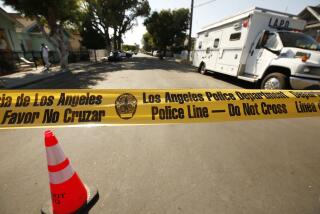LAPD Seeks to Use Pepper Gas to Overcome Hostile Suspects : Police: Council’s decision awaited on switch to what is touted as a more effective chemical spray.
- Share via
The Los Angeles Police Department is seeking City Council approval to arm its officers with a pepper-based chemical spray that is widely used by law enforcement agencies nationwide to temporarily debilitate hostile suspects.
The cayenne pepper gas--which causes severe inflammation of the eyes and nose, breathing difficulties and a burning sensation on the skin for about half an hour--is more effective than the tear gas spray canisters officers now carry, said LAPD training Sgt. Glenn Hess.
The gas has been used by LAPD officers in the Van Nuys, Hollywood, Rampart and 77th Street divisions for the last two months in a pilot project sponsored by the state attorney general’s office.
With the support of Chief Willie L. Williams, LAPD representatives Wednesday asked the City Council for approval to provide the gas to all officers on a temporary basis. Although several council members voiced support, the lawmakers delayed until Tuesday a decision on whether to fund the $200,000 project.
Officers involved in the pilot project have used the spray about 50 times, successfully detaining suspects about 95% of the time, Hess said. The Sheriff’s Department has issued the gas to 182 deputies and has found that it worked 77% of the time in 44 uses. Most of the failures occurred when it was applied to those under the influence of drugs, said Lt. Jim Mulvihill.
Nationwide, the spray is used by agencies ranging from the FBI, which issues it to new agents, to the National Park Service, which employs a potent form on wild bears.
“There is hardly a bad thing to say about it from a law enforcement viewpoint,” said Jim Pledger, chief of the firearms training unit at the FBI Academy in Quantico, Va. “I have not heard of a single case where a person has suffered permanent injury or lingering health effects.”
In Long Beach, however, a man who was allegedly under the influence of rock cocaine died after he began gasping for air when sprayed with pepper gas Tuesday night in what was the local Police Department’s first use of the product. Police say it was most likely the cocaine and not the gas that caused the death of Carol Calvin Domingue, 40, of Louisiana.
“I don’t know why this guy died,” said Long Beach Lt. Ken Shack. “We suspect cocaine overdose. In my opinion the pepper gas did not lead to his death in any way.”
The American Civil Liberties Union of Southern California said it supports the idea of expanding the non-lethal weaponry available to police but has yet to see long-term health data on pepper gas or learn of possible side effects.
“If there is a suspicion that the first application in Long Beach resulted in a fatality where pepper gas might have played a role, we would hope the Police Commission and LAPD would proceed with great caution,” said ACLU spokesman Allan Parachini.
Replacing tear gas spray with the pepper spray would prompt more officers to use it as an alternative to the baton and probably lead to fewer lawsuits against the city, said LAPD Cmdr. Rick Dinse, who heads the department’s training operations.
“The officers do not have confidence in the (spray) now being used,” Dinse said. “They rarely use it.”
The pepper spray would add to the department’s middle-range uses of force, which include stun guns and batons, designed to restrain aggressive, but not life-threatening, assailants.
The state last August granted provisional approval to two manufacturers of pepper gas--ZARC International and Defense Technology Corp. of America--and is allowing law enforcement agencies to try the gas temporarily while the state Environmental Protection Agency examines its environmental and health effects.
Agencies using the product during the test period must provide details of the effects of each use to the attorney general’s office. If the LAPD gets approval to use the gas departmentwide next week, it will have to report back to the council in six months on the status of training, use and effects.
Before utilizing the gas on the street, officers must be trained in its use. One part of that training is having the product used on them so they understand its effects.
More to Read
Sign up for Essential California
The most important California stories and recommendations in your inbox every morning.
You may occasionally receive promotional content from the Los Angeles Times.










